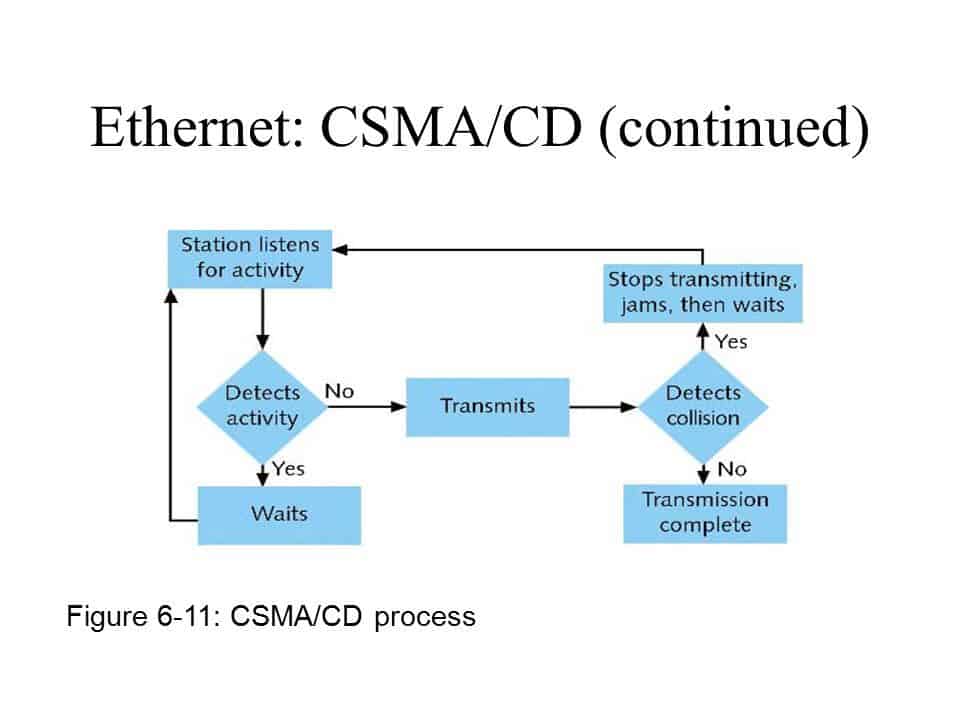CSMA/CD – Carrier Sense Multiple Access / Collision Detection

Short for Carrier Sense Multiple Access / Collision Detection, a set of rules determining how network devices respond when two devices attempt to use a data channel simultaneously (called a collision). Standard Ethernet networks use CSMA/CD to physically monitor the traffic on the line at participating stations. If no transmission is taking place at the time, the particular station can transmit. If two stations attempt to transmit simultaneously, this causes a collision, which is detected by all participating stations. After a random time interval, the stations that collided attempt to transmit again. If another collision occurs, the time intervals from which the random waiting time is selected are increased step by step. This is known as exponential back off.
CSMA/CD is a type of contention protocol. Networks using the CSMA/CD procedure are simple to implement but do not have deterministic transmission characteristics. The CSMA/CD method is internationally standardized in IEEE 802.3 and ISO 8802.3.
CSMA/CD (Carrier Sense Multiple Access with Collision Detection) is a network protocol used primarily in Ethernet networks to manage how devices share the same communication channel and avoid data collisions. It is a method for controlling access to a shared transmission medium, ensuring that data packets are transmitted efficiently and that collisions are detected and resolved.
Key Concepts of CSMA/CD:
- Carrier Sense (CS):
- Definition: Before a device (such as a computer or network interface card) attempts to send data on the network, it first listens to (or “senses”) the carrier, which is the shared communication medium, to check if it is currently being used by another device.
- Purpose: The device ensures that the channel is free and no other device is transmitting at that moment to avoid collisions.
- Multiple Access (MA):
- Definition: Multiple devices are connected to and share the same communication medium, such as an Ethernet cable or a wireless channel.
- Purpose: It allows all devices on the network to access the medium, but they must coordinate to avoid sending data simultaneously, which would cause a collision.
- Collision Detection (CD):
- Definition: If two devices transmit data simultaneously, a collision occurs. In CSMA/CD, each device can detect this collision by monitoring the network while it is transmitting. If a collision is detected, the devices stop transmitting immediately.
- Purpose: The detection of collisions allows devices to take corrective action, ensuring that the network can recover and continue to operate efficiently.
How CSMA/CD Works:
- Carrier Sensing:
- A device that wants to send data checks the network to see if it is idle or busy. If the network is busy, the device waits until it becomes idle.
- Data Transmission:
- When the network is idle, the device begins transmitting its data packet.
- Collision Detection:
- While transmitting, the device continues to monitor the network. If it detects that another device has transmitted data at the same time (resulting in a collision), it stops transmitting immediately.
- Collision Handling:
- The device then sends a special signal known as a “jam signal” to inform all other devices that a collision has occurred.
- After the jam signal, each device involved in the collision waits for a random amount of time (using a backoff algorithm) before attempting to retransmit its data. This reduces the likelihood of repeated collisions.
- Retransmission:
- Once the random backoff time has passed, the device will try to transmit its data again, starting with carrier sensing to ensure the network is idle.
Limitations of CSMA/CD:
- Efficiency: CSMA/CD is effective in reducing collisions on small, lightly loaded networks. However, as network traffic increases or the number of devices on the network grows, the likelihood of collisions increases, reducing overall network efficiency.
- Network Size: CSMA/CD works best in networks with shorter cable lengths and fewer devices because the time required to detect collisions is shorter, reducing the chance of undetected collisions.
- Obsolescence: With the advent of modern Ethernet technologies like full-duplex communication and switches, where each device has a dedicated channel, CSMA/CD has become largely obsolete in contemporary network designs.
Applications:
- Ethernet Networks: CSMA/CD was a fundamental protocol in early Ethernet (10Base-T and 100Base-T) networks, particularly those using a shared medium like coaxial cables or hubs.
- Legacy Systems: Although it is less common today, CSMA/CD principles may still apply in older or specialized networks where shared communication channels are used.
In Summary:
CSMA/CD is a protocol that manages how multiple devices access a shared network medium, ensuring efficient communication by sensing the medium, detecting collisions, and resolving them when they occur. While essential in early Ethernet networks, it has been largely superseded by more advanced networking technologies in modern systems.